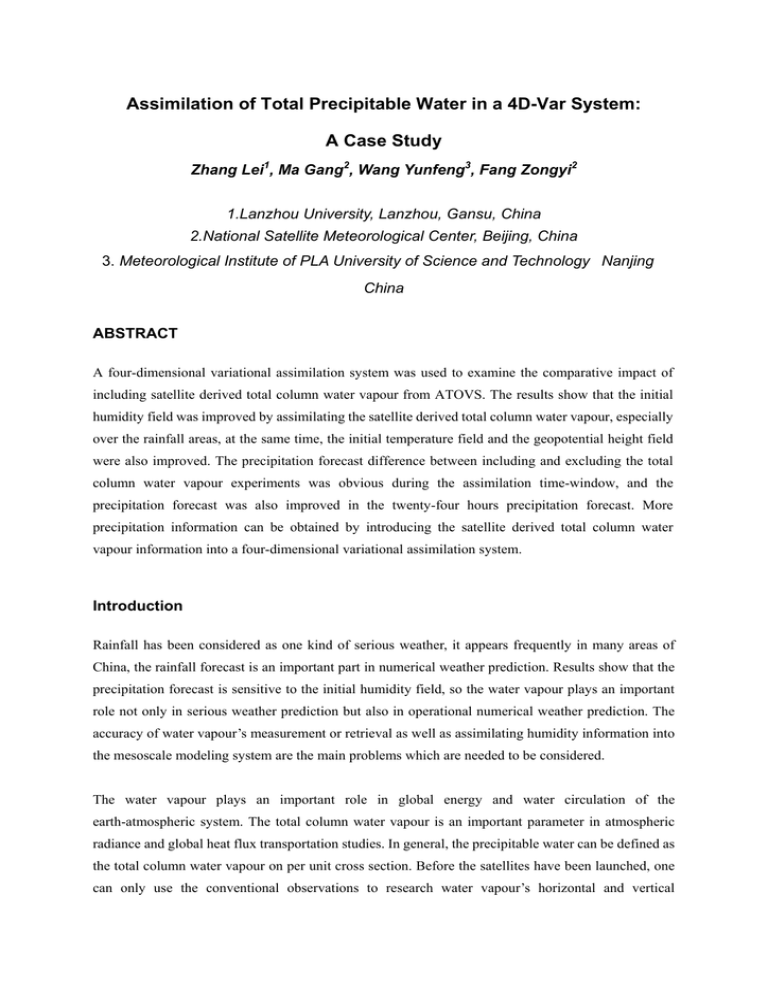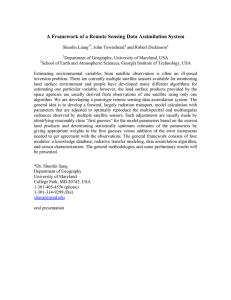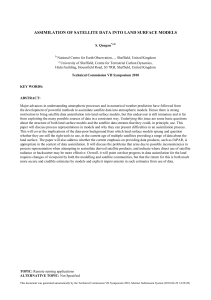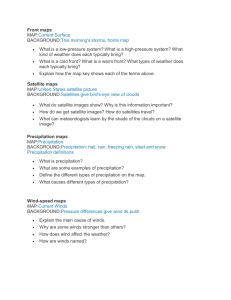Assimilation of Total Precipitable Water in a 4D-Var System:
advertisement

Assimilation of Total Precipitable Water in a 4D-Var System: A Case Study Zhang Lei1, Ma Gang2, Wang Yunfeng3, Fang Zongyi2 1.Lanzhou University, Lanzhou, Gansu, China 2.National Satellite Meteorological Center, Beijing, China 3. Meteorological Institute of PLA University of Science and Technology Nanjing China ABSTRACT A four-dimensional variational assimilation system was used to examine the comparative impact of including satellite derived total column water vapour from ATOVS. The results show that the initial humidity field was improved by assimilating the satellite derived total column water vapour, especially over the rainfall areas, at the same time, the initial temperature field and the geopotential height field were also improved. The precipitation forecast difference between including and excluding the total column water vapour experiments was obvious during the assimilation time-window, and the precipitation forecast was also improved in the twenty-four hours precipitation forecast. More precipitation information can be obtained by introducing the satellite derived total column water vapour information into a four-dimensional variational assimilation system. Introduction Rainfall has been considered as one kind of serious weather, it appears frequently in many areas of China, the rainfall forecast is an important part in numerical weather prediction. Results show that the precipitation forecast is sensitive to the initial humidity field, so the water vapour plays an important role not only in serious weather prediction but also in operational numerical weather prediction. The accuracy of water vapour’s measurement or retrieval as well as assimilating humidity information into the mesoscale modeling system are the main problems which are needed to be considered. The water vapour plays an important role in global energy and water circulation of the earth-atmospheric system. The total column water vapour is an important parameter in atmospheric radiance and global heat flux transportation studies. In general, the precipitable water can be defined as the total column water vapour on per unit cross section. Before the satellites have been launched, one can only use the conventional observations to research water vapour’s horizontal and vertical characteristics as well as its variation, it is hard to know how the water vapour distributes horizontally and vertically over the whole world, especially over the mountain areas and the ocean areas due to the sparseness of the observational data over these areas. But it is difficult to meet the needs in atmospheric and oceanic research. Satellite data can be considered as a complement to the conventional observation data. Satellites can provide global temperature and humidity information, including the horizontal and vertical information as well as their variation at different times. To retrieve the total precipitable water from satellite data, many researchers have done work; for example, Yang et al (1996) have established an experiential relationship between the precipitable water and the surface water vapour pressure, Li et al (2001) have explored a method to retrieve the total precipitable water based on GMS-5 infrared satellite data. With respect to the numerical weather prediction, it is important to obtain the real-time observational data, especially to obtain the water vapour, because generally the water vapour varies quickly from time to time. Some researchers have explored a few methods to solve this problem, such as regression method (Wang et al, 2004), but these methods can not provide real observational data. In addition, there is ‘spin-up’ in precipitation forecast in 3D-Var or other data assimilation methods. Many researchers have explored a lot of methods to solve this problem, such as Fiorino et al(1981), Krishnamurti et al(1984), Donner et al(1988), Zhu(1999), but these methods cannot guarantee the initial field’s consistency in dynamics. Four-dimensional variational assimilation has the ability to assimilate different kinds of observational data at different times into the modeling system within the assimilation time-window. So, in a sense, the four-dimensional variational assimilation can be regarded as a way to solve those problems presented above. The objective of 4D-Var is to find an optimal model state that minimizes in a least-square sense the distance between a selected output quantity of the model and its observed equivalent, given a background constraint. In four-dimensional assimilation system, the observation data can be assimilated in the raw or almost raw forms and it is relatively easy to assimilate indirect observation data such as satellite data into the modeling system. By doing this, the error in data retrieval process can be avoided or eliminated. The sparseness of observational data has been thought of the most serious difficulty encountered in improving numerical weather prediction in China. As for the precipitation assimilation, there are many research studies focusing on the conventional or sounding data assimilation, but as for the remote sensing data assimilation such as the satellite retrieved precipitation data assimilation, there are not many. In this study, the comparative impact and the potential improvement in precipitation modeling were explored by assimilating the satellite retrieved total column water vapour, and some conclusions were obtained. Session 2 presents four-dimensional variational assimilation theory, 4D-Var experiments results are presented in session 3, in session 4, some conclusions are obtained. Theory and model Given an atmospheric background state of model input variable and an operator (H) that relates to the model state to a set of observations, it is possible to solve the inverse problem in a variational context and derive the atmospheric state for which the least–square distance between the observations and their model counterparts reaches its minimum. This is obtained by minimizing the following functional J ( x(t0 )) = 1 1 N ( x(t0 ) − xb )T B −1 ( x(t0 ) − xb ) + ∑ ( y (t n ) − H ( x(t n )))T O −1 (t n )( y (t n ) − H ( x(t n ))) 2 2 n =0 = Jb + Jo in this study, we can write the functional in details: J ( x(t0 )) = 1 N 1 ( x(t0 ) − xb )T B −1 ( x(t0 ) − xb ) + ∑ ( pw(tn ) − pwobs (tn ))T O −1 (tn )( pw(tn ) − pwobs (tn )) 2 n =0 2 = Jb + Jo where x(t0 ) is the control variables at initial time, x denotes u, v, t, p’, q, w, u and v are horizontal wind speed, w is vertical wind speed, t is the temperature, q is the specific humidity and p’ is the pressure perturbation, xb is the background field, it is obtained from NMC T213 forecast, B is the background error covariance matrix for model’s control variables, J b is the background, J o is the forcing term, pw(t n ) is the total column water vapour calculated by model at the n’th time level during the assimilation time-window, n=1, …, N, N is the number of additional observational data, pwobs (t n ) is the observed total column water vapour retrieved from ATOVS satellite data. O −1 presents the error covariance of the observational data. In 4D-Var, the objective is to find an optimal state x(t0 ) for the model by minimizing the function presented above. The result of the retrieval is therefore a combination of the background and of the observation, weighted by the inverse of their respective error statistics. The minimization of the function is performed using the quasi-Newton descent algorithm. It requires the calculation of the gradient of the function defined in the function. In this study MM5 4D-Var system is used. Experiments setup The center of the test domain is set as 31.5°N, 112.5°E. Total grids are 61*61, grid spacing is 54km. The primary precipitation from 22 to 25 July 2002 is distributed from 25°N, 110°E to 35°N, 120°E. Data in two orbits of NOAA16 are used in the data assimilation, the primary precipitation areas are included in the orbit areas. Figure 1 shows the test domain and the satellite data distribution which are treated in the assimilation time-window. The NMC T213 forecast field is used as the background field at the beginning of the assimilation, the assimilation time-window is set 6 hours from 22, July 2002 00UTC to 22, July 2002 06UTC, the total column water vapour retrieved from NOAA 16 are used in the assimilation. 50 40 30 20 80 90 Figure 1 100 110 120 130 satellite data over the test domain Two experiments are run in order to examine the impact on precipitation forecast after assimilating satellite derived total column water vapour. One is the ‘control’ run--- run without satellite data information, the other is the ‘test’ run--- run with the satellite data information. Comparison between the control experiment and the test experiment at the initial time Specific humidity Specific humidity Specific humidity relative humidity relative humidity relative humidity temperature temperature temperature geopotential height geopotential height geopotential height Figure 2a 850hpa Figure 2b 500hpa Figure 2c 300hpa Fig 2 the increment of different control variables at the initial time at different levels We compared the specific humidity at different pressure levels between the control experiment and the test experiment. The results show that the initial specific humidity field was improved obviously after assimilating the total column water vapour into the modeling system, the initial relative humidity field was also improved. At the same time, the initial temperature field and geopotential height field as well as the initial wind field were also improved although the improvements of those variables were not as obvious as that of humidity field (see to figure 2). Difference of total precipitable water between the control experiment and the test experiment at the initial time To get more details about the assimilation effects, the difference of total precipitable water between including and excluding satellite data experiment was compared. Figure 3 shows that more details were obtained after introducing the satellite data into the modeling system. Figure 3 comparison of the total column water vapour between with and without satellite data at the beginning of assimilation. Left: without satellite data, Right: with satellite data Impact of assimilating satellite data on precipitation forecast An impact study is performed on the period from July 22nd to July 25th 2002. The “CTRL” experiment is the run without assimilating satellite data, the “TEST” is the same run with the additional satellite data assimilation in 6-hour assimilation time-window. The model was integrated 72 hours. Figure 4a is the 6-hour precipitation forecast in control run, Figure 4b is the 6-hour precipitation forecast in test run, figure 4c is the observed precipitation during the same period. Figure 4c shows that there are four primary precipitation centers, three centers lie in the area from 25°N to 30°N from 100° E to 120°E another lies in the area from 35°N to 40°N from 110°E to 115°E. After 6 hours integration of the MM5 forward model, the simulated precipitation centers in test experiment consist with the observed results better than those in the control experiment, the total precipitation in the test experiment is much closer to the observed total precipitation than that in the control experiment. Figure 5 presents the 24-hour precipitation forecast from t+00 to t+24. Figure 5a, 5b is respectively the 24-hour precipitation forecast in control and test experiment, figure 5c is the observed 24-hour precipitation during the same period. The results show that the precipitation forecast has been improved after introducing the satellite data into modeling system, the results of the test experiment are closer to the observed precipitation than those of the control experiment. a c b 45 Figure4 comparison of 6-hour precipitation forecast from t+00 to t+06(unit: mm) a. without satellite data b. with satellite data c. observed precipitation 40 35 30 25 20 95 100 105 110 115 120 125 130 Figure6 and Figure7 are similar to the Figure5, but the forecast period is from t+24 to t+48 and from t+48 to t+72, respectively. The results show that the precipitation forecast for these periods are also improved. a b c 45 Figure5 comparison of 24-hour precipitation forecast from t+00 to t+24(unit: mm) a. without satellite data b. with satellite data c. observed precipitation 40 35 30 25 20 95 100 105 110 115 120 125 a 130 b c 45 40 Figure6: similar to Figure5, but from t+24 to t+48 35 30 25 20 95 100 105 110 115 120 125 130 a c b 45 40 Figure7: similar to Figure5, but from t+48 to t+72 35 30 25 20 95 100 105 110 115 120 125 130 Conclusion The results show that the initial humidity field was improved by assimilating the satellite derived total column water vapour, especially over the rainfall areas, at the same time, the initial temperature field and the initial geopotential height field were also improved. The precipitation forecast difference between including and excluding the total column water vapour experiments was obvious within the assimilation time-window, the precipitation forecast was improved evidently in twenty-four hours precipitation forecast. To the longer precipitation prediction, the similar improved forecast was produced after the assimilation of the total precipitable water. More precipitation information can be obtained by introducing the satellite derived total column water vapour information into the four-dimensional variational assimilation system. Acknowledgement The authors would like to thank Prof. Chong-jian Qiu for suggestions and comments to improve the initial manuscript during the course of this work. References Wolcott S T,Warner T T. A humidity initilization utilizing surface and satellite data. Mon Wea Rev, 1981, 109 (9) :1989-1998. Kou Y H. Assimilation of precipitable water measurements into a mesoscale numerical model. Mon Wea Rev , 1993,121 (4) : 1215-1238. Zhang D L, Fritsch J M. A case study of the sensitivity of numerical simulation of mesoscale convective system to varying initial conditions. Mon Wea Rev, 1986, 114 (12): 24182-2431. Shen Tongli et al experiment and design of the variational analysis system for the satellite cloud picture data in the limited area Pateau Meterology, 996, 15 (1) 58-67 Yang Jingmei et al The empirical expression of the relation between precipitable water and ground water vapour pressure for some areas in China Journal of Atmospheric Science,1996, 20 (5) : 620-626 Yao Zhanyu et al Estimation of water vapour distribution using combied datafrom GMS-5 and ground station, Climate and Environmental Research, 2001, 6 (2) : 197-202. Kou Y H, Zou X, Guo Y R. Variational assimilation of precipitation water using a nonhydrostatic mesoscale adjoint model. Part I: moisture retrieval and sensitivity experiments. Mon Wea Rev, 1996, 124 (1) : 122-147. Xiao Q , Zou X, Kuo Y H. Incorpo rating the SSMˆI2derived precipitable water and rainfall rate into a numerical model: A case study for the ER ICA IOP 24 cyclone. Mon Wea Rev, 2000, 128 (1): 87-108. Li Xiaoli et al Adjoint assimilation system of mesoscale models and its assimilation experiments Journal of Nanjing Institute of Meteorology,2002, 25 (1) : 36-44 Wu Chengou et al Appropriate-time regression method for deriving relative humidity fromsatellite cloud picture and the influence diagnosis, Journal of Nanjing Institute of Meteorology, 2001, 24 (2) :162-164. Wang Hongli et al The retrieval of precipitable water and its application to the numerical simulation of torrential rain, Journal of Nanjing Institute of Meteorology, 2004 27 4 443-450 FiorinoM,et al, Incorporating surface winds and rainfall rates into the initialization of a mesoscale hurricane model, Mon Wea Rev,1981,109, 1914 Krishnanmurti T N,et al, Details of low latitude medium range numerical wather prediction using a global spectral model II: effect of orography and physical initialization, J Meteoro Soc Japan, 1984,62,613 Krishnanmurti T N, et al, Cumulus parameterization and rainfall rates, Mon Wea Rev, 1988, 116, 583 Donner L J, An initialization for cumulus convection in numerical weather predction models, Mon Wea Rev, 1988, 116, 377 Zhu Guofu Observation data assimilation and precipitation prediction of the limited-area numerical model in the early stage Acta Scientiarum Naturatium, Universitatis Pekinensis, 1999 35 1 81 Courtier P , Talagrand O. Variational assimilation of meteorological observations with the direct and adjoint shallow water equations, Tellus, 1990, 42A: 531 - 549








